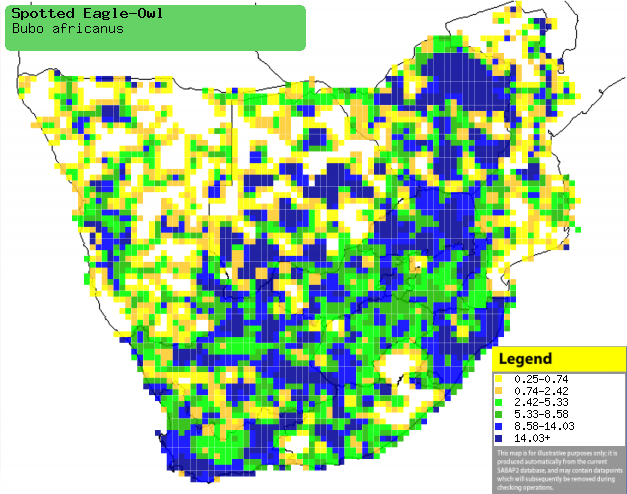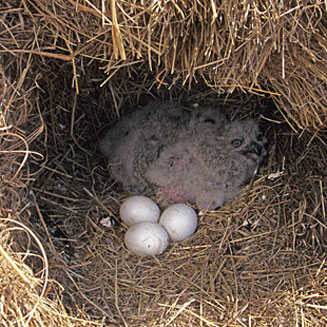|
Bubo africanus (Spotted
eagle-owl)
Gevlekte ooruil [Afrikaans]; Ifubesi (also applied to
Verreaux's eagle owl), Isihulu-hulu [Xhosa]; isiKhovampondo (also applied to
Cape eagle owl) [Zulu]; Editika (generic term for eagle owl) [Kwangali];
Makhohlo, Morubisi, Sehihi, Sephooko [South Sotho]; Sikhova [Swazi]; Xiyinha
[Tsonga]; Makgotlwę, Mophoę, Morubise (these terms also applied to Verreaux's
eagle-owl) [Tswana]; Afrikaanse oehoe [Dutch]; Grand-duc africain [French];
Fleckenuhu, Berguhu [German]; Bufo-malhado [Portuguese]
Life
> Eukaryotes >
Opisthokonta
> Metazoa (animals) >
Bilateria >
Deuterostomia > Chordata >
Craniata > Vertebrata (vertebrates) > Gnathostomata (jawed
vertebrates) > Teleostomi (teleost fish) > Osteichthyes (bony fish) > Class:
Sarcopterygii (lobe-finned
fish) > Stegocephalia (terrestrial
vertebrates) > Tetrapoda
(four-legged vertebrates) > Reptiliomorpha > Amniota >
Reptilia (reptiles) >
Romeriida > Diapsida > Archosauromorpha > Archosauria >
Dinosauria
(dinosaurs) > Saurischia > Theropoda (bipedal predatory dinosaurs) >
Coelurosauria > Maniraptora > Aves
(birds) >
Order: Strigiformes
> Family: Strigidae
The Spotted eagle-owl is a familiar bird in many parts of
southern Africa, and lives in a wide range of habitats. It has an
extremely varied diet, eating anything from poisonous snakes and carrion to
falcons and insects. It breeds in most months in the year, nesting in a variety
of different places. There are usually 2-3 chicks in one brood, up to 6 chicks
in good years. Juveniles are only fully independent 4 months after leaving the
nest.
Distribution and habitat
Occurs across sub-Equatorial Africa in most habitats,
excluding sandy deserts and high grassland. It is most prolific in open scrub
and low grassland, so long as it has suitable roost
sites. It has also adapted to living with humans, occurring in many towns and
cities in southern Africa, roosting in buildings and trees and using
streetlights as perches.
|
 |
|
Distribution of Spotted eagle-owl in southern Africa,
based on statistical smoothing of the records from first SA Bird Atlas
Project (©
Animal Demography unit, University of
Cape Town; smoothing by Birgit Erni and Francesca Little). Colours range
from dark blue (most common) through to yellow (least common).
See here for the latest distribution
from the SABAP2. |
Predators and parasites
Food
It has an extremely varied diet - over 60 species have been
recorded as prey. It mainly hunts at night, only rarely coming out in the day
to follow
Honey badgers to bee's nests. The type of food it eats varies greatly
between different areas and habitats, although rodents, small birds and shrews
typically form the bulk of it's diet. The following prey items have been recorded in
its diet.
- Vertebrates
- Invertebrates
- insects
- arachnids
- snails
- crabs
- millipedes
- moths
- Other
- dead fish
- carrion
- rare cases of cannibalism on road kill carcasses
Breeding
- Uses a wide variety of nest sites; in one study, 61% used shallow
holes/crevasses in the ground, 26% nested in trees or tree stumps and the
remaining 13% nested in buildings. It sometimes has to compete with
Egyptian geese for nesting sites.
 |
|
|
Spotted eagle-owl nest with eggs, Settlers, South
Africa. [photo
Warwick Tarboton ©] |
|
- Egg-laying season is almost year-round,
peaking from August-December.
- There are usually 2-3 eggs in one clutch, laid at 1-4 day intervals,
although it can be as a high as six eggs in good years.
- Incubation is done solely by the female, while the male brings food to
the nest. Incubation starts with the first egg laid and continues for 29-33
days.
- In nests on the ground the chicks leave the nest 30-38 days after
hatching, but in raised nests, they only leave the nest after 40-42 days.
The juveniles stay around the nest for 6-8 weeks, while learning to hunt.
They become fully independent at about four months old.
Threats
Not threatened, in fact common in large areas of southern
Africa.
References
-
Hockey PAR, Dean WRJ and Ryan PG (eds) 2005. Roberts
- Birds of southern Africa, VIIth ed. The Trustees of the John Voelcker
Bird Book Fund, Cape Town.
|
